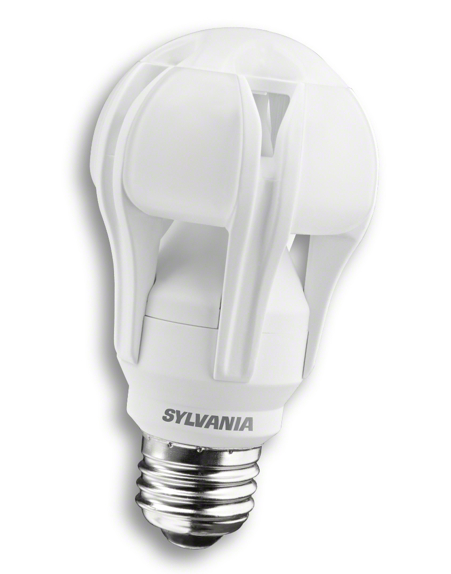The future of reading: A 100-watt LED bulb and a bank loan


Often when we write about LED light bulbs on SmartPlanet, readers write in to say they're still waiting for a 100 watt-equivalent version - something bright enough to read by, many of you note. A bulb that is, that exceeds the 40-watt, 60-watt and 75-watt versions that have hit the market.
Well, your wish is Osram Sylvania's command. And Philips'. And GE's. Each of those companies have over the last week indicated their intentions to put 100-watt equivalent LED bulbs on retail shelves this year. They join others like Switch Lighting who have earlier announced 100-watt equivalent bulbs.
LED bulbs, for those of you, er, in the dark, portend tremendous savings in energy consumption and the attendant CO2 emissions and fuel bills. They require only about a fifth of the power of conventional incandescent bulbs, which many governments are banning in a CO2-reduction campaign. An LED that shines as brightly as a traditional 100-watt bulb in principle requires only 20 watts.
One problem has been that manufacturers have not been able to make them in brighter versions that many American eyes demand for reading (Europeans are accustomed to lower wattages as they slog through War and Peace or whatever. Even with light, it seems, Americans have a reputation for excess. I'm not taking sides. I'm an American living in the UK, where my eyes have worsened. It has nothing to do with getting older. And I still haven't made it past page 152 of Tolstoy. I digress).
Alas, you will soon have more energy efficient choices for illuminating your dark corners, following the annual Lightfair International exhibition, which took place in a brightly and probably not so energy-efficiently lit city called Las Vegas last week.
For Philips forthcoming offering, check out a story by Martin LaMonica on our sister site CNET. GE's bulb has received a fair amount of coverage in recent days, including in Forbes.
I'll focus on Osram Sylvania's bulb, called the A21 (why can't light bulbs be "Mustangs" or "Apples" or "Jet Flares" or something? Why do their names have to evoke uninspiring industrial sockets?) Osram Sylvania, a unit of German company Siemens, is positioning the A21 as the best of the bunch based on a combination of efficiency and light quality.
The bulb runs on 20 watts of power, less than Philips' 23 watts and GE's 27 watts, Osram Sylvania notes. And while Switch Lighting's 100-watt equivalent also weighs in at 20-watts, Osram Sylvania says the A21 beats Switch on color rendition and color temperature -- two areas of performance where LED bulbs are still inferior to incandescents.
For those of you who like numbers: Osram Sylvania says the A21 gives off 1600 lumens of light, has a color temperature of 2700 K, and a color rendering index of 80.
In the LED game of leapfrog and "mine is better than yours," it can be hard to tell the difference between brands. For instance, while Osram Sylvania's impressively low 20 watts emits 1600 lumens of light, the slightly more power hungry Philips 100-watt equivalent bulb yields a slightly brighter level closer to 1700 lumens. Both are in the "100 watt equivalent" ballpark, when compared to the lumens from an incandescent bulb.
But one thing all of these offerings seem to have in common: They're going to cost you a whole lot more than what you're accustomed to paying for a light bulb. You can sometimes pick up an incandescent bulb for less than buck.
I asked Osram Sylvania how much they'll charge for the A21 LED. They wouldn't even drop a clue. They're talking to retail partners "to confirm pricing" before the bulbs go on sale this summer, the company told me.
Talk is cheap, but LED light bulbs are not. Philips will charge $60, with a $10 rebate, according to CNET. The Forbes article "hopes" that the GE bulb will be under $50.
I'm being slightly facetious here. I do accept that LEDs will cost us more, and that we'll make up the difference on energy savings, and on longevity - the bulbs are supposed to last for 25 years, although we don't actually know yet that they will.
But $60? Especially in today's tough economy? That's a bank loan if you replace all your bulbs at once.
I can hear the typical domestic conversation across America. "Sorry honey, we can't afford to go out for dinner tonight. I bought a light bulb today. Why don't we stay in and read War and Peace?"
Photos: Light bulb from Osram Sylvania. Picture of Louis Lejeune's Battle of Moscow (aka Borodino) from Wikimedia Commons.
A sampler of more bright LED insights on SmartPlanet:
- Philips developing rare earth substitute for LEDs,says CEO
- Does Siemens have world's most efficient LED?
- Philips CEO: LED bulb prices must fall to ‘well below $10″
- The LED that gives more power than it takes
- An LED bulb under $5
- Broadening the appeal of LEDs: Taiwan’s wide beam bulb
- More LED truths and half-truths
- When good lights go bad: LED breakdown
- The hot and cold of LED lighting
- Bridgelux shatters LED efficiency record with silicon tech
- Switch Lighting unveils 100W equivalent LED bulb
This post was originally published on Smartplanet.com